Common Cycling Injuries
Neck Pain
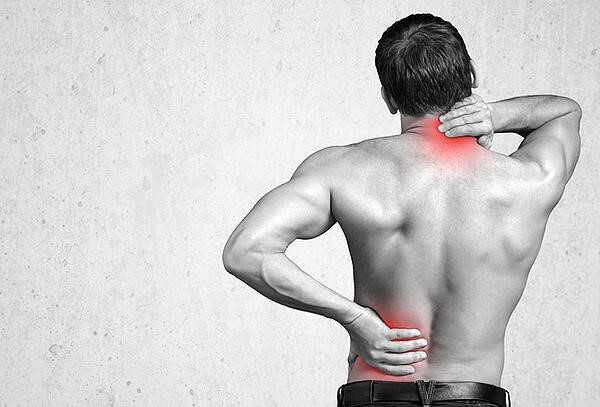
Pain in the sides of necks, between our neck and shoulders, as well as in the lower back are frequent ailments that golfers face regularly. Often, these are muscle-related pain due to lack of stretching before and after the games or poor swing biomechanics.
The trapezius muscle is a large muscle that extends from the back of our skull, to the upper back between our shoulder blades (scapula) and towards the lower thoracic spine. It works hard to support the weight of our arms, control and rotate our scapula and spine, and contract to extend our neck (when we hold our head up or look upwards).
Imagine the stress on our trapezius muscles as we address the ball in a stable posture, proceed to rotate our spine in the backswing and release during the down swing through impact and follow-through! And as a bogey player, I do this at least 90 times in a game. It is no wonder we get neck, upper and lower back aches playing our favourite sport.

The latissimus dorsi muscle is the largest muscle in the upper body, covering most of the lower back and stretches to the sides and arms. It facilitates movement of the arms, shoulders and works synergistically with other muscles of the lower back when you lean over, arch your back backwards, and flex your back sideways. It does not work in isolation but works with other muscles in the lower and upper back. Tight latissimus dorsi muscles are known to contribute to chronic shoulder and back pain since this muscle connects the spine to the upper arms (humerus).

Prevention is better than cure
A pre-game routine and stretch is crucial to prevent these injuries. A proper 5- or 10-minute stretch focusing on our necks, shoulders, upper and lower back is important. Early arrival to a game between 30 to 45 minutes also helps to calm the body, allowing for gradual improvement in our tempo when going into our game.
Late to the game and your friends are already on the first tee box? It might not be a bad idea to let them tee off first while you stretch. Start on the second hole after a good stretch, otherwise you might pull a muscle and drag your first ball into the nearby stream.
What would be considered a serious neck or back injury?
Everyone gets the occasional neck and back pain. These symptoms are often mild to moderate and get better with rest, stretching, and with simple analgesics.
Some signs that the pain you are experiencing is more serious than originally thought include the following:
● Constant pain at rest and at night despite adequate rest and care● Pain that wakes you up at night● Sharp shooting pain to your arms● Tingling, numbness and/or weakness in your arms and fingers● Clumsiness in your hands e.g., difficulty holding a pen or chopsticks, unable to button your shirt● Clumsiness or instability when walking● Trouble going to the toilet● Sharp shooting pain to your legs (This may or may not be associated with tingling and numbness in the calves or toes)
If you experience any of the symptoms above, you are advised to seek medical help from a doctor or orthopaedic surgeon.
Neck and Upper Back Pain
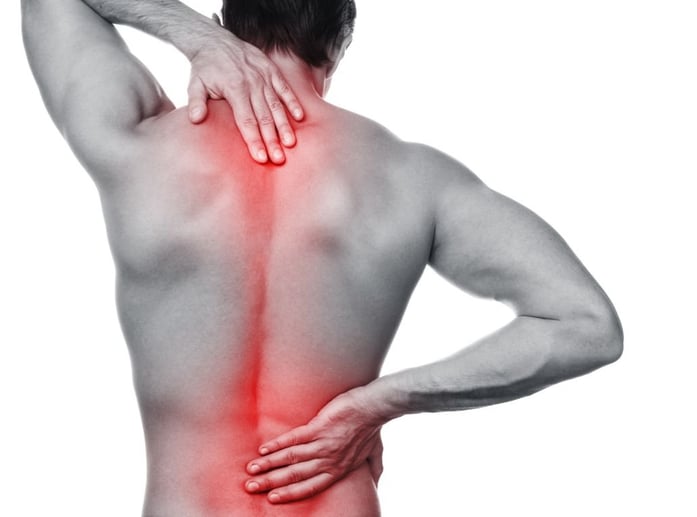
Causes of back pain in cyclists
There are a multitude of factors that can contribute to neck and upper back pain in cyclists. These are often treatable once the underlying problem has been rectified. It may also be due to several factors that contribute to the pain. Pain may be attributed to intrinsic or extrinsic factors.
○ Poor posture while cycling○ Riding a bike that does not fit○ Not getting a bike-fit before riding a new bike (bike is too big or too small, saddle is too high or too low). When in doubt, do seek advice from a bike-fitter or mechanic at a reputable local bike shop.○ Extended cycling distances (riding 100km for the first time)○ Poor physical conditioning○ A fall from your bicycle
What can happen if injuries are left untreated?
○ Cycling is an exciting and enjoyable sport. Untreated or poorly managed injuries may compromise your safety and enjoyment while cycling. ○ If neck and upper back pain are untreated, it may lead to chronic muscle cramps, difficulty sleeping at night and even headaches. ○ Injuries of the wrist or shoulder may cause difficulty controlling your bicycle. Ankle or knee pain might make it difficult for you to climb hills or detach your cycling cleats from your pedals. These injuries might increase the risk of you falling and further aggravating your injuries.○ It is best to seek professional help if you are experiencing an injury to allow you to return to cycling sooner rather than later.
Treatment options
It is important to identify the cause of your neck and upper back pain from cycling. Extrinsic factors such poor bike fit and ill-fitting equipment must be identified and rectified. During a clinical bike fit, the master bike-fitter will ensure your bike set up is optimised to allow efficient pedal strokes and performance. They will also advise you about your posture during rides as well as pedal techniques to prevent muscle and joint pains.
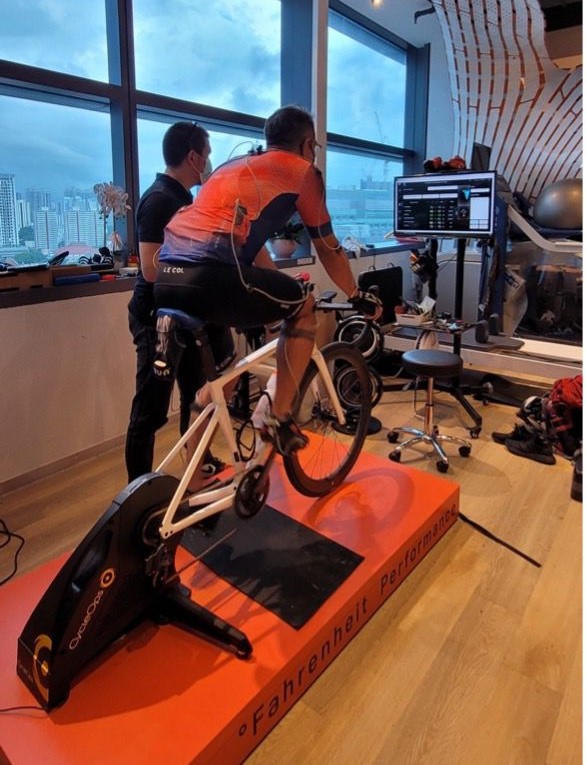
There are probes attached to Dr Mizan’s upper and lower limb joints that allows his posture and cycling patterns to be tracked.
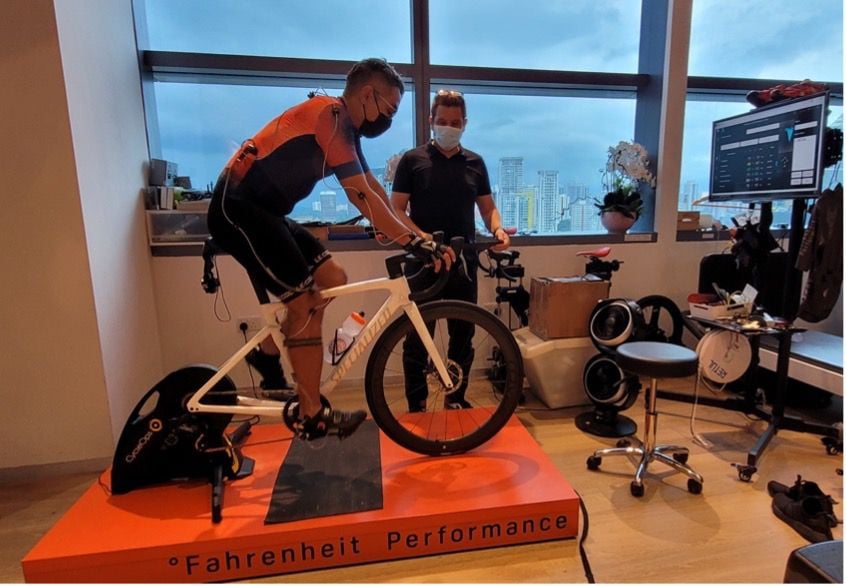
Bike fittings promote cycling comfort and aerodynamics. It allows us to enjoy our sport safely and comfortably! Muscle pain or tightness will improve after a period of rehabilitative physiotherapy and stretching. Well-trained physiotherapy will identify the tight muscles causing the pain and allow focused muscle relaxation and improved functioning.
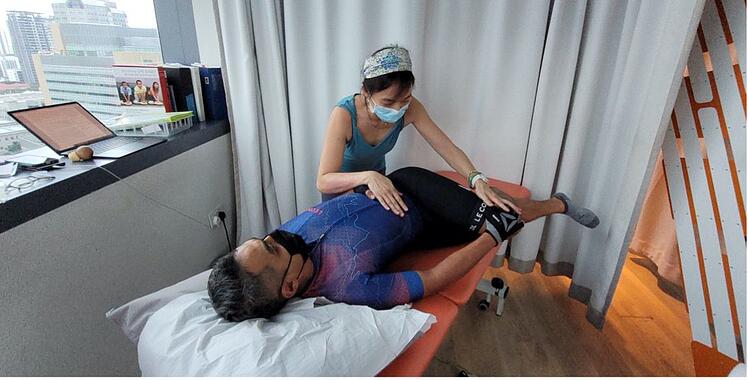
Physiotherapists can identify specific muscle, joint or ligament problems which impair your cycling performance.
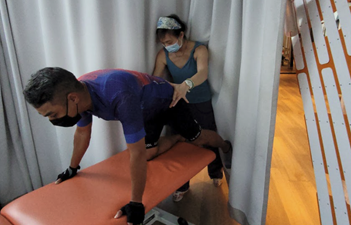
Muscle imbalances can also affect the way you cycle and may lead to injuries. After releasing tight muscles, they may advice you no certain exercises or stretches to do ono your own to improve your muscle and cycling performance.
○ Regular passive and active range of motion exercises of the neck, upper back and shoulders will help alleviate the pain and tightness. This is something that you should do routinely during the course of your day. Well-conditioned and balanced muscle tone can help prevent injuries and improve your cycling performance.○ It is also important to use good and comfortable pillows when you sleep. Your pillow should conform and support the curvature of your neck and spine.
Recovery
The speed of your recovery depends on the cause of the injury and whether it has been correctly rectified. Anti-inflammatory medication and stretching exercises should help reduce your neck and upper back pain before you return to cycling.
Return to cycling short distances with good posture to prevent recurrent pain.
What to do now while waiting for diagnosis/treatment?
Stop cycling for a while and practice passive and active stretching exercises of your neck, upper back and shoulders. These regular exercises will reduce your pain and stiffness.
Photos courtesy of Performance Sports & Rehab Specialists (www.performanz.com.sg)
Knee Pain
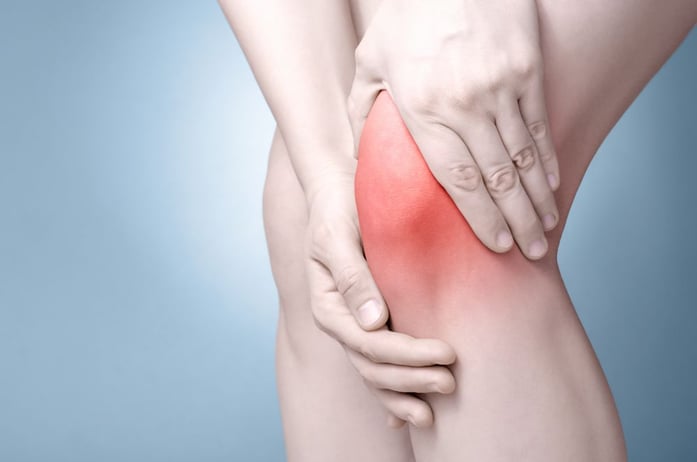
What are the causes of knee pain in cyclists?
- Cycling is a very popular recreational and competitive sport in Singapore. Cycling related injuries, especially around the knee are common and preventable. There are multiple reasons for knee pain in cyclists and are focused on intrinsic and extrinsic factors.
- Intrinsic or cyclist-related factors include the following:
- Poor conditioning: weak quads or tight hamstring/calf muscles may lead to knee pain, especially if it involves cycling long distances or up hills.
Sources of knee pain include:
- Tight iliotibial bands
- Patella or quadricep tendinitis
- Patello-femoral pain syndrome
- Cycling technique: while it might be common sense to most about how to pedal a bike, there are several factors to consider which will significantly affect your cycling comfort and prevent injuries
- Adjust your saddle to improve comfort: higher, lower, forwards or backwards
- Relax your upper body: Do not apply too much pressure on your arms or shoulders as this will lead to upper back and neck pain after rides
- Shift to an easier gear as you push off or when going up hills: this will all your muscles to warm up and reduce muscle aches
- Go long and slow: this helps prevent lactic acid from building up in your muscles that may lead to aches and pains.
- Experiment with a variety of cadences: easy gears will allow you to use a higher cadence and stress your muscles less. This is also good when going up hills and steep inclines. When there are no flats, you may use a higher gear with lower cadence for more speed.
- Practice pedalling drills. The 12 o’clock to 5 o’clock pedal stroke is where you generate the most power. Learn to spin in circles to make each stroke pedal more efficient and fluid.
- Poor conditioning: weak quads or tight hamstring/calf muscles may lead to knee pain, especially if it involves cycling long distances or up hills.
- Poor bike fit
- It is crucial to get bike fitted if you are serious about cycling. It helps improve your biomechanics; adjustments to the bike geometry are made to suit your body type and cycling style. Getting a bike of the correct size is just the beginning.
- The heel-to-pedal method is a quick way to adjust your saddle height. Place your heel on the pedal and place the pedal at the 6 o’clock position. Your knee should be completely straight. If your knee is still bent, you need to increase the height in small increments each time. If your heel loses contact with the pedal, then simply lower the saddle accordingly. Your knees should bend at an angle of 30 degrees at each downstroke of the pedal. Reaching the optimal height may take some trial and error with lots of small adjustments along the way.
- Crank length also affects the way you cycle and the height of your saddle. Cyclists with a low saddle height, on a small bike, should use a short crank length to improve their pedalling efficiency.
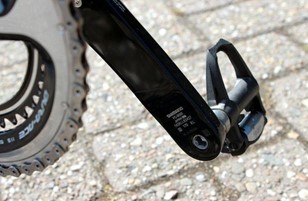
What can happen with neglected knee pain?
○ We cycle because it is fun and it provides us with some form of exercise to keep ourselves fit. Persistent and niggly knee pain takes that fun out of cycling and prevents us from reaching our fitness potentials.
○ Undiagnosed structural injuries like meniscal tears and cartilage wear may eventually lead to arthritis which may prevent you from cycling altogether.
○ It is best to get any form of knee pain checked out so that simple problems may be addressed early before they deteriorate into something more complex.
Treatment options
○ We would always recommend a simple bike fit to ensure your bike is best adjusted to your body-type and cycling styles
○ Minor knee injuries may be managed with rest, anti-inflammatory medication and physiotherapy to stretch out those tight muscles.
○ Knee injections are a non-surgical technique to relieve pain and inflammation in your knees
○ Surgery is always a last resort if there are structural injuries detected on MRI scans.
Recovery
○ Most niggly knee injuries get better with adequate rest and care.
○ It is important to do some dynamic stretching before cycling and statis stretching exercises after your fun on the bike. Good stretching improves your physical performance and prevents delayed onset muscle soreness (DOMS).
Wrist and Arm Pain
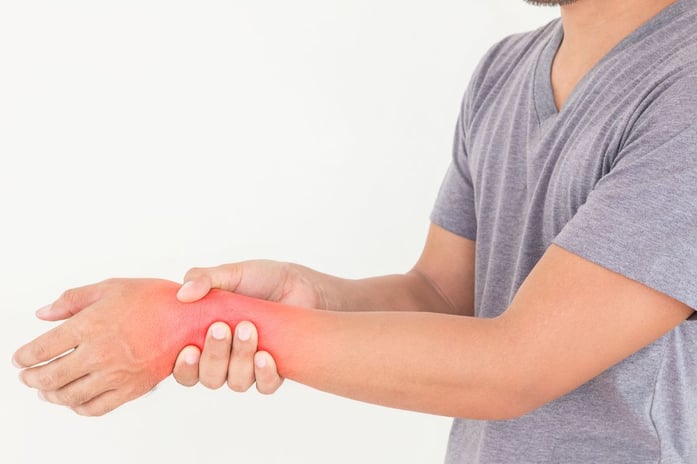
Wrist pain is a common cycling injury and it happens when there is hyperextension of the wrist, especially when you are riding ‘DROPS’ or ‘HOOKS’ position for prolonged periods of time (see pictures below). Pain and numbness of your ring and little finger (handlebar palsy) may also happen due to compression of the ulna nerve in that region.
Allow your wrist to relax in a more ergonomic position such as the ‘RAMPS’ or ‘TOPS’ positions to prevent wrist pain and numbness. Most of the time, cyclist have to alternate their hand and wrist position as they negotiate inclines and change their gears or apply brakes as they ride.
○ Carpal tunnel syndrome may occur due to compression of the median nerve in your wrist. You may experience pain and numbness in your thumb, index, middle and half of your ring finger. It is worse when riding on uneven ground or cobblestones.
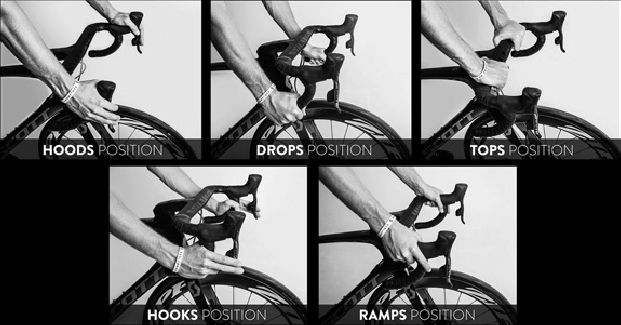
○ Elbow pain may occur due to undue stress to the elbow over long periods of cycling. This may occur if you lock your elbows while cycling or cycle oover uneven ground such as cobble stones. Elbow pain can occur on the outside (lateral) or inside (medial) side of the elbow, depending on the position of your arms and wrist while you ride your bike. This pain is mostly related to inflammation of tendons in your elbow [(tennis elbow (lateral epicondylitis) and golf elbow (medial epicondylitis)] and tends to resolve with adequate rest and care. If elbow pain is related to numbness in your ring and little finger, this may be due to compression of the ulnar nerve (cubital tunnel syndrome) as it winds around your elbow.
What can happen if wrist or elbow pain is left untreated?
○ Niggly or simple wrist and elbow pain may deteriorate to something more chronic and debilitating if left untreated. This may reduce your cycling time and level of enjoyment. Surgery is rarely needed to manage these problems.
Treatment options
○ It is important to cycle using cycling gloves as well as tape across the handle bars. This allows for a more comfortable grip and prevent injuries.
○ Alternate your hand and wrist position as you ride your bike so that areas of stress can allowed to relax and recovery during the course of the ride.
○ Try not to lock your elbows when you cycle as it transmits strenuous forces through the upper limb, back and neck.
○ If the pain persists, consider adjusting the handle bars and have a bike fit from a professional. You may be experiencing these upper limb symptoms due to too much weight being put through your hands and wrist. A reason for this may be that your saddle is too high or your handlebars are too low. A bike that is too big or a top tube that is too long may leave you stretched out and focus too much strain on your elbows and wrists.
○ If you are experiencing finger weakness or numbness, please see an orthopaedic surgeon to exclude a nerve compression. A nerve conduction study is done to diagnose both carpal tunnel syndrome and cubital tunnel syndrome. Both these conditions have a good chance of recovery with changes in physical activity and rest. If this fails, a small surgical procedure may be required to release the compression on these nerves so that they may recovery.
Recovery
○ Most wrist and elbow conditions recover with several days or a week of rest.
What to do now while waiting for diagnosis/treatment?
○ If you are having persistent or worsening wrist pain despite adequate rest and selfcare, consider taking some anti-inflammatory medication to reduce the pain and swelling in your wrists.
Impact/Crash Injuries
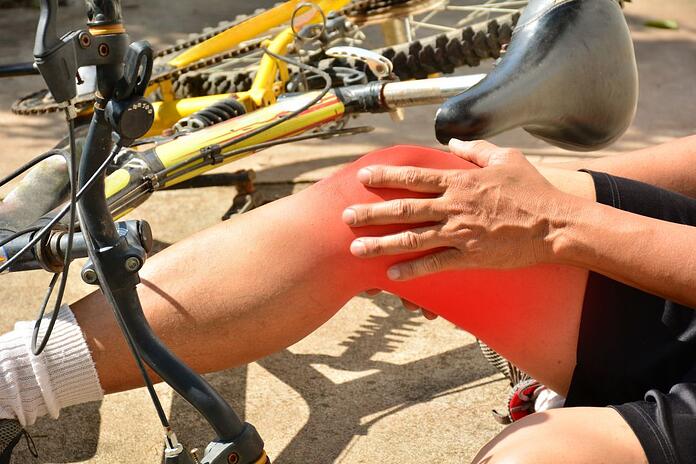
Why do cycling accidents happen?
− There are a variety of reasons why cyclists fall from their bikes:
− There is a wide spectrum of cyclists in our community including children who are just learning to balance on their new bikes, adult cyclists on recreational bikes, and more seasoned cyclists on road or triathlon bikes.
− These cyclists may be found on park connectors, trails or along our main roads travelling at low or high speeds.
− Falls may be due to external environmental factors such as pot-holes, uneven ground, slippery surfaces or even debris and rocks on the ground. High human or road traffic conditions may make it difficult for cyclists to negotiate their way around and cause them to lose balance. This is especially true during the COVID-19 border closures where we are all around the Singapore parks and beaches.
− Some of us are not familiar with cycling or are riding bikes which do not fit our height and body type. Poor equipment and physical conditioning can easily cause us to fall and hurt ourselves.
− Some avid cyclists spend many hours in the saddle cycling around the country. Fatigue and loss of concentration, especially when you are hunched over a road bike can lead to falls and injuries.
Common Injuries
− Multiple injuries can occur when cyclists fall from their bike. This may be related to the speed they are travelling and the way the hit the ground on impact.
− Common injuries include the upper limb and shoulders. Cyclists often break their fall with their shoulder or their wrist. At great speeds, awkward falls can lead to fractures of the collar bone (clavicle), wrist and elbow. There are often muscles contusions around the upper and lower back, as well as the hips and knees.
− These days it is compulsory to wear a helmet when cycling on open roads. This has helped reduce the number of serious head injuries that cyclists sustain when they fall.
Should I seek help after a fall?
− It is important to seek help when you have just fallen from your bike, especially if it is a high impact accident or you are seriously hurt.
− Initial first aid is important. This includes applying pressure over a bleeding wound. If you are unable to stand or walk, it is best to get help from a friend or family member to take you to the nearest emergency department.
− If you had fallen some time ago but are still feeling significant pain or loss of function from an injury, it is prudent to get the injury assessed by a trained professional. An Xray, ultrasound scan or an MRI scan may be required to accurately diagnose the injury.
Treatment Options
− Initial selfcare is important after a fall. This includes protecting the injured area with some compression, applying ice and elevating the injured limb to reduce the swelling. Anti-inflammatory medication is required to reduce the pain and swelling from the injury.
− After a week or two, the pain and swelling should improve. If this has not happened, it might be a good idea to seek professional help.
Recovery
− Most sprains and contusions improve after two or three weeks of adequate rest and selfcare. If you are keen to return to cycling, first ensure that your bicycle is in good working order or you may fall again due to a damaged bike.
− Start cycling slowly with a high cadence over short distances as a starting point. If this initial cycle does not pose any major problems, you may start cycling longer distances at your own pace.
What to do now while waiting for diagnosis/treatment?
− Self-care may be practiced while waiting to be seen by an orthopaedic surgeon or physiotherapist. If your pain or symptoms are too much to bear, do seek immediate help from your local doctor.
Statistics
Factual sentences referenced across top search results:
● Allow your body to adapt to the increased time spent riding by increasing your mileage slowly, by no more than 20% per week. (blog.mapmyrun.com) ● Your recovery week should include some cross training, rest days, and a 30–40% decrease in your total weekly mileage. (blog.mapmyrun.com) ● In fact, a survey of more than 100 pro cyclists during training camps showed that back pain accounted for the majority 45 percent of aches and pains. (bicycling.com)
● Corrected for the temporal trends in crash and injury rates across all intersections in the Netherlands: national data that showed a 2 to 13% decrease over the study period. (ncbi.nlm.nih.gov)
● 8% reduction in bicyclists' crash rate and 30% reduction in injury rate were observed following installation of new roundabouts. (ncbi.nlm.nih.gov)
● Among the 3 styles of roundabouts, those with cycle tracks had the greatest reductions in injuries to cyclists and moped users (90%), compared to those with no bicycle infrastructure (41% reduction) and those with a cycle lane (25% reduction). (ncbi.nlm.nih.gov)
● There was an 8% increase in crash frequency in the study area, but bicycle volume on these intervention sections grew by 50% more than unchanged streets - authors conclude that the intervention may have resulted in a safety improvement. (ncbi.nlm.nih.gov)
● Risk of crash/injury depends on number of coloured crossings: 1 crossing = 10% reduction for injuries/19% for crashes; 2 crossings = (ncbi.nlm.nih.gov)
● Bike lanes estimated to reduce collision frequency by 53%. (ncbi.nlm.nih.gov)
● Multiple logistic regression, comparing infrastructure of injured cyclists (at location of injury event) and of cyclists from the national probability sample (infrastructure where cyclist rode more than 50% of the time). (ncbi.nlm.nih.gov)
● Self-reporting (survey): 280 respondents who had a crash or fell in the last 12 months Multiple logistic regression comparing odds ratios for having a collision or fall versus not, according to primary riding surface of the cyclist. (ncbi.nlm.nih.gov)
● Presence of lighting on rural roads reduces bicyclist injuries by ~60%. (ncbi.nlm.nih.gov)
● In addition, there is an important safety gap between cyclists and other transport modes: estimates from both continents suggest that cyclists are seven to 70 times more likely to be injured, per trip or per kilometre traveled, than car occupants [ ]. (ncbi.nlm.nih.gov)
● Carpal tunnel syndrome: Clinical manifestations and diagnosis (healthline.com)
● Evidence does not support magnet therapy About 5% of people in the United States have carpal tunnel syndrome. (en.wikipedia.org)
● Up to 33% of people may improve without specific treatment over approximately a year. (en.wikipedia.org)
● This is exceedingly rare (less than 1%). (en.wikipedia.org)
● Obesity also increases the risk of CTS: individuals classified as obese ( BMI > 29) are 2.5 times more likely than slender individuals (BMI < 20) to be diagnosed with CTS. (en.wikipedia.org)
● This joint review concluded median and sensory nerve conduction studies are valid and reproducible in a clinical laboratory setting and a clinical diagnosis of CTS can be made with a sensitivity greater than 85% and specificity greater than 95%. (en.wikipedia.org)
● The test characteristics of Phalen's maneuver have varied across studies ranging from 42–85% sensitivity and 54–98% specificity. (en.wikipedia.org)
● Tinel's sign (pain or paresthesias of the median-innervated fingers with percussion over the median nerve), depending on the study, has 38–100% sensitivity and 55–100% specificity for the diagnosis of CTS. (en.wikipedia.org)
● It accounts for about 90% of all nerve compression syndromes In the U.S., 5% of people have the effects of carpal tunnel syndrome. (en.wikipedia.org)
● Only 10% of reported cases of CTS are younger than 30 years. (en.wikipedia.org)
● Research shows that anywhere from 23 percent 33 percent of cyclists have suffered from cycling-related knee pain at one point or another. (bicycling.com)
● Instead, start with a lower mileage and build slowly, increasing your total mileage no more than 10 percent each week. (bicycling.com)
● In a survey of 109 professional cyclists, nearly a quarter (23%) reported having knee pain in the last 12 months. (cyclingtips.com)
● In a Californian cross-sectional study involving 518 cyclists, 41.7% reported knee injuries, with a low level of cycling experience being associated with increased prevalence. (cyclingtips.com)
● The standard recommendations are that you should increase your mileage by no more than 10% at a time. (cyclingtips.com)
● It will be different for everybody and doesn't necessarily fit within the generic 10% guidelines. (cyclingtips.com)
● Increasing your mileage by more than 10% each week can harm your knees or lead to injuries in other parts of your body as well. (heidenortho.com)
● The 10-percent rule is a good one to follow. (active.com)
● Once you're there, increase your miles by no more than 10 percent per week. (active.com)
● Several epidemiological studies have shown that experiencing knee pain or knee injuries ranges between 14.8% and 33% in cyclists involved in long-duration pedaling. (ncbi.nlm.nih.gov)